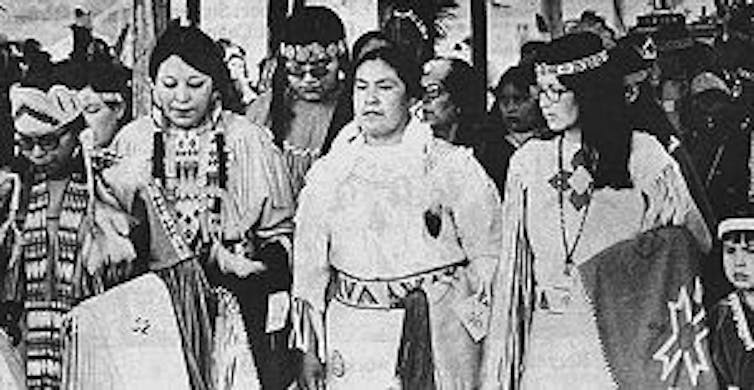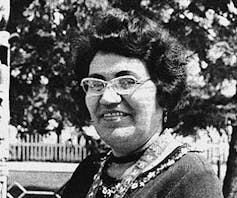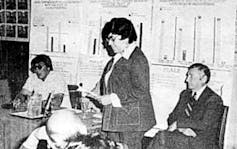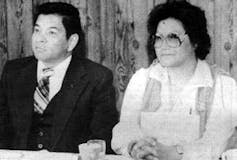Although Indigenous activism in Canada has a long history, the origin stories of official and formalized organizations are hidden from common view because of gaps in history books and media accounts. The early formations of Indigenous women’s organizing in Saskatchewan is an example of these resilient stories hidden from history.

Indigenous women who remained on reserves in Saskatchewan throughout the 20th century, when government-designed third world conditions made survival precarious, organized to challenge those conditions.
Isabelle McNab, president of the Saskatchewan Indian Women’s Association (SIWA) in the 1970s and Sadie Cote, president of SIWA from 1979, are two such women (Irene Tootoosis of Cutknife was the first president in 1971). McNab was instrumental in the formation and expansion of SIWA, an organization of treaty Indian women who lived on reserves in Saskatchewan.
READ MORE: ‘There’s nothing left there’ — A founder of Canada’s first healing lodge says CSC dismantled vision
The sexist Indian Act had prevented women from either voting in band elections or holding office from 1876 until 1951. A revised Act enabled Indigenous women to participate politically, and take their rightful roles to ensure the health and well-being of their communities, especially the elders and children.

Saskatchewan News
McNab’s journey from the personal to the political in the 1960s was one many women embarked upon during the second wave of feminism. In 1974, McNab reflected on her entrance into Indian women’s politics, and her role in its expansion, to a reporter from the Saskatchewan Indian, a local newspaper.
“One day I was walking to town to get groceries — we didn’t have a vehicle and I thought to myself, dammit, I don’t have to be this poor. There has to be a way out for me.”

‘Saskatchewan Indian’
Daughter of Chief John Gambler, a staunch advocate for treaty rights in Saskatchewan and the leader of the Protective Association for Indians and their Treaties (PAIT) in the 1940’s and the granddaughter of “The Gambler,” a critically important leader at Treaty 4 negotiations in 1874, McNab came from a long line of Indian leadership in the Treaty 4 area. Originally from Muskowpetung First Nation, McNab married into neighbouring George Gordon First Nation in the Touchwood Hills area of Saskatchewan.
Despite being discouraged by Indian Affairs, her chief, Hilliard McNab suggested McNab attend university in Saskatoon and take a teacher’s aide course. Once she got to school, McNab’s passion for education caught the attention of fellow students and professors.
“I was always being asked to go and speak at different places …,” said McNab. “There was never an idle moment after that.”
WATCH BELOW: Rep. Deb Haaland becomes first Indigenous member of Congress sworn in

Third-world conditions

Get daily National news
Indigenous women’s political activism in Saskatchewan was shaped by the cultural and historic experiences of colonization, broken treaty promises and loss of land; racial discrimination and sexualized violence; and, unfortunately, the prevalence of sexism within their own Indigenous communities.
During the late 1960s, with Prime Minister Pierre Trudeau’s release of the 1969 White Paper, “a Canadian government policy paper that attempted to abolish the Indian Act and all treaties, and assimilate all Indian peoples under the Canadian state,” Indigenous political activism took on an intensified vigour.

In the 1960s and 1970s on reserves in Saskatchewan, the infant mortality rate for Indian and Métis people was more than double that of non-Native Canadians. One in five deaths was a result of violence, compared to one in twenty in non-Native society.
In 1973, fewer than four per cent of reserves had running water, and two per cent had indoor toilets.
Only half a per cent of the First Nations and Métis student population was in Grade 12, and approximately 60 per cent of Indigenous students were behind in their grade; 60 per cent of Indigenous people were unemployed.
Indigenous women who laboured on reserves under these third world conditions saw gender balance in Indigenous leadership as crucial to the solutions and they brought an Indigenous feminist perspective of treaty rights.
On Sept. 1, 1971, the newly formed Saskatchewan Indian Women’s Association met in Prince Albert. SIWA identified four focus areas: to help women organize; to prevent young people from drug and alcohol misue; to stop juvenile delinquency on reserves; and to promote the importance of education to on-reserve families.

Despite these conditions and the lack of formal political support, Indigenous women continued to press forward positively. On the reserves, SIWA women’s clubs played an education role, distributing information on nutrition, birth control and environmental health and as well as counselling. SIWA also sought to assist women leaving violence and end alcohol misuse.
READ MORE: Indigenous women coerced into sterilizations across Canada: Senator
Racial and gender stereotypes
Attempting to work within the colonial Indian Act regime hampered Indigenous self-determination, but the First Nations women of SIWA also faced resistance from some First Nations men in power. In adopting Eurocentric notions of male dominance taught in residential schools, the male leadership was initially dismissive of SIWA.
As well, negative racial stereotypes of Indigenous women pervaded Prairie society. The women of SIWA sought to present new images of First Nations women derived from a positive depiction of strong Indigenous mothers and women.
Although many Indigenous women’s groups occasionally worked alongside and within larger Indigenous political organizations, neither mainstream feminist nor Indigenous organizations met the specific needs of Indigenous women.
After much discussion, on-reserve Indian women decided their best way forward was to affiliate with the provincial Indian organization, the Federation of Saskatchewan Indians (FSI). However, SIWA’s relationship to the FSI was tenuous and remained that way throughout this period.
As president of SIWA, McNab initially took a conciliatory approach when making a case for gender-balanced leadership in the FSI. She described their political activities as non-threatening:
“these ladies have a lot they can offer to support their men in, doing what has to be done for Indian people… As Indian women we respect our men very much … [Women] have proven themselves as assets and as leaders, they’ve proven themselves in their training, and they’ve proven themselves in the self-respect they have.”
WATCH BELOW: Trudeau addresses questions about MMIW and indigenous languages

‘We are the mothers:’ Sadie Cote
After a two year lapse, First Nations women revived SIWA in 1979, led by Sadie Cote from the Yorkton District. The revitalized association continued to press for a formal role in the FSI.
By 1980, Indian women in Saskatchewan had amplified their demands for change. In the article “Women Wage War,” President Sadie Cote’s tone changed significantly from earlier meetings.
Cote demanded:
“Where are the so-called heads of the households? The so-called elected leaders of the bands? … we as mothers are trying to keep our homes and raise our children properly. No wonder we have so many juvenile delinquents; very young people turning to drugs and alcohol. There is absolutely no future for the young people to look forward to.”

Saskatchewan News
The women waged a war on both alcohol and political apathy, calling on male First Nations leaders to step up and join them in the raising of the next generations. As a mother, Cote drew attention to the experiences of families on reserves living under the federal Indian Act regime:
“We are the mothers who have to accept and not complain about the pathetic substandard housing units, poor heating systems, and no indoor plumbing or running water. We are the mothers who have to contend with the poor health services provided to Indians at the reserve level. We are the mothers that have to walk with a sick child a number of miles in order to see a doctor.”
Cote drew attention to the colonial conditions imposed by the Canadian state as little better than the genocidal Nazi “final solution:”
“It was not our fault that we were herded onto small parcels of lands, known today as Indian reserves. These small reserves are little better than the concentration camps we read about from the Second World War.”
First Nations women in Saskatchewan struggled mightily to gain a voice in Indigenous politics in Saskatchewan through decolonizing gender relations to create communities that were safe, nurturing and above all, conducive to reproducing Indigenous nations into the future.
These women represented both an innovation in First Nations politics but also drew inspiration from the past. As they sought to decolonize Indian politics and fight for treaty rights, SIWA demanded their return to their rightful place in Indigenous leadership.Allyson Stevenson, Tier II Canada Research Chair in Indigenous Peoples and Global Social Justice, University of Regina
This article is republished from The Conversation under a Creative Commons license. Read the original article.
- Officials stress Calgarians must save water after Bearspaw main break sees no drop in usage
- Yukon-Alaska border rocked by 3 earthquakes in final hours of 2025
- Canadians ring in 2026 with ‘invigorating’ polar plunges across the country
- Snowmobiler dies in avalanche in Rocky Mountains in northeastern B.C.








Comments